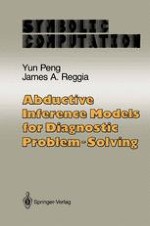1990 | OriginalPaper | Chapter
Probabilistic Causal Model
Authors : Yun Peng, James A. Reggia
Published in: Abductive Inference Models for Diagnostic Problem-Solving
Publisher: Springer New York
Included in: Professional Book Archive
Activate our intelligent search to find suitable subject content or patents.
Select sections of text to find matching patents with Artificial Intelligence. powered by
Select sections of text to find additional relevant content using AI-assisted search. powered by
A limitation of parsimonious covering theory presented in the last chapter is that the solution Sol(P) for a diagnostic problem P = < D,M,C,M+ > may include a large number of alternative hypotheses. This occurs because Sol(P) is defined to be the set of all irredundant covers of M+. In order to further select from these potential explanations, some criteria other than parsimony are needed, and additional information must be integrated with the cause-effect associations in the knowledge base to support such disambiguation. As we reviewed in Section 2.1, besides symbolic causal knowledge, numeric probabilistic knowledge that captures the uncertain nature of causal relationships among diagnostic entities is also crucial for successful diagnosis. Therefore, one natural approach to cope with this problem would be to incorporate probabilistic knowledge into the model and to derive a computationally feasible likelihood measure as a means of ranking hypothesized explanations. Unfortunately, although a number of previous diagnostic expert systems have tried to do so, their approaches have been very limited and usually heuristic in nature [Shortliffe75, Duda76, Ben-Bassat80, Charniak83].
